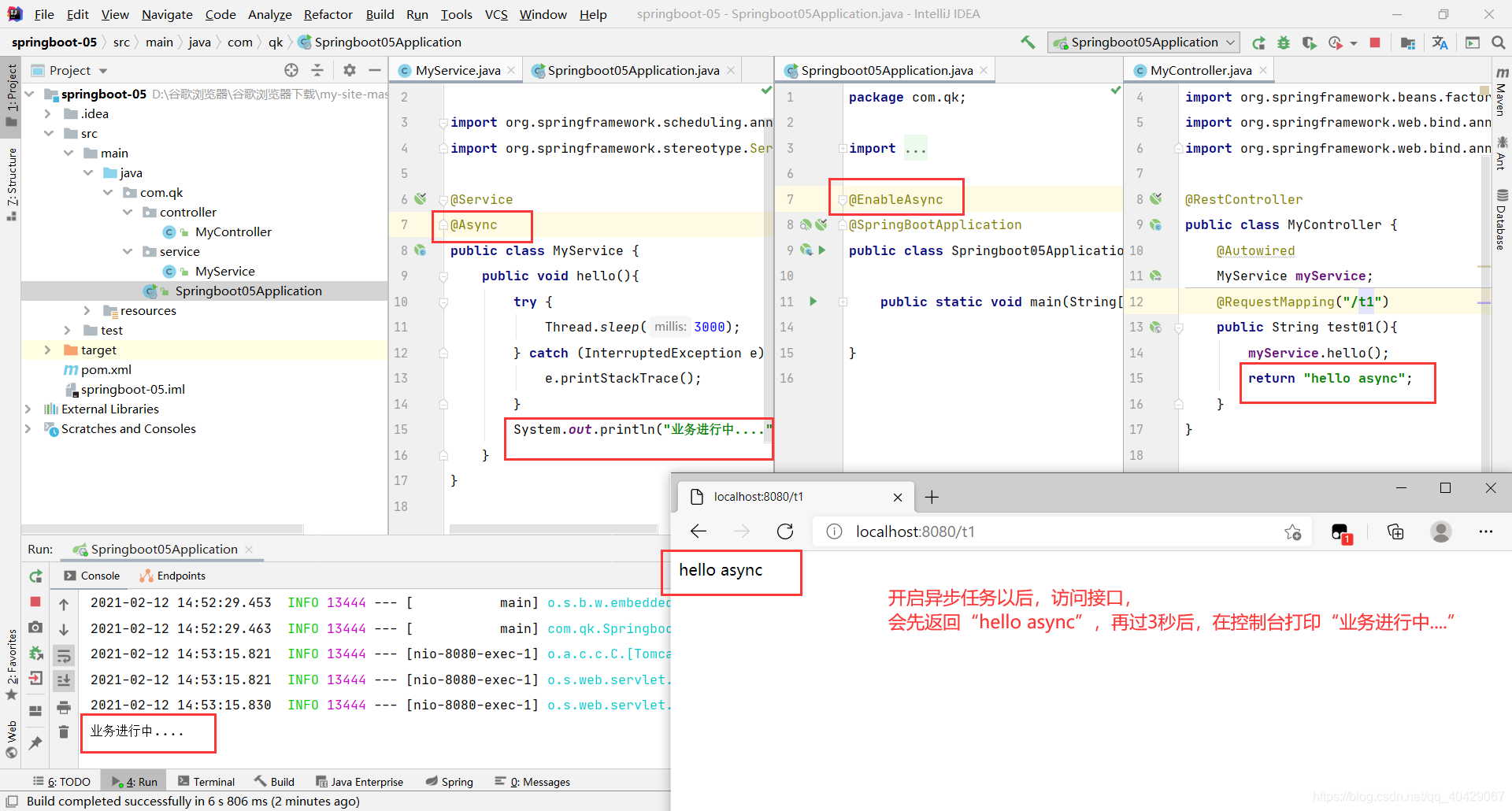SpringBoot-Web-异步、定时、邮件任务
本文共 2985 字,大约阅读时间需要 9 分钟。
异步任务
按照调用顺序执行任务

开启异步任务
@Async 在异步任务上使用异步注解
@EnableAsync 在主程序上开启异步注解功能
定时任务
在要定时执行的的方法上通过@Scheduled,写好corn表达式,指定定时任务执行的频率
- 不要其他方式的调用,写好corn表达式,开启注解,启动主程序就可以了
@Servicepublic class MyService { //秒 分 时 日 月 周几 @Scheduled(cron = "0 12 15 * * 0-7") public void hello(){ System.out.println("定时任务"); }} - 在主程序开启定时任务功能
//开启基于注解的定时任务@EnableScheduling @SpringBootApplicationpublic class Springboot05Application { public static void main(String[] args) { SpringApplication.run(Springboot05Application.class, args); }} 常用的corn表达式
(1)0/2 * * * * ? 表示每2秒 执行任务(1)0 0/2 * * * ? 表示每2分钟 执行任务(1)0 0 2 1 * ? 表示在每月的1日的凌晨2点调整任务(2)0 15 10 ? * MON-FRI 表示周一到周五每天上午10:15执行作业(3)0 15 10 ? 6L 2002-2006 表示2002-2006年的每个月的最后一个星期五上午10:15执行作(4)0 0 10,14,16 * * ? 每天上午10点,下午2点,4点(5)0 0/30 9-17 * * ? 朝九晚五工作时间内每半小时(6)0 0 12 ? * WED 表示每个星期三中午12点(7)0 0 12 * * ? 每天中午12点触发(8)0 15 10 ? * * 每天上午10:15触发(9)0 15 10 * * ? 每天上午10:15触发(10)0 15 10 * * ? 每天上午10:15触发(11)0 15 10 * * ? 2005 2005年的每天上午10:15触发(12)0 * 14 * * ? 在每天下午2点到下午2:59期间的每1分钟触发(13)0 0/5 14 * * ? 在每天下午2点到下午2:55期间的每5分钟触发(14)0 0/5 14,18 * * ? 在每天下午2点到2:55期间和下午6点到6:55期间的每5分钟触发(15)0 0-5 14 * * ? 在每天下午2点到下午2:05期间的每1分钟触发(16)0 10,44 14 ? 3 WED 每年三月的星期三的下午2:10和2:44触发(17)0 15 10 ? * MON-FRI 周一至周五的上午10:15触发(18)0 15 10 15 * ? 每月15日上午10:15触发(19)0 15 10 L * ? 每月最后一日的上午10:15触发(20)0 15 10 ? * 6L 每月的最后一个星期五上午10:15触发(21)0 15 10 ? * 6L 2002-2005 2002年至2005年的每月的最后一个星期五上午10:15触发(22)0 15 10 ? * 6#3 每月的第三个星期五上午10:15触发
链接: .
邮件任务
发送一个简单邮件
- 导入依赖
org.springframework.boot spring-boot-starter-mail
- 编写配置文件 application.properties
spring.mail.username=2500813866@qq.comspring.mail.password=kxhfocyyrnmuecif#qq就qq.com#网易就163.com#新浪就sina.comspring.mail.host=smtp.qq.com# 如果使用qq,还需要开启加密验证,其他的邮箱不需要# 键值对 mail.smtp.ssl.enable:truespring.mail.properties.mail.smtp.ssl.enable=true
- 注入一个邮箱发送实现类(不需要自己编写),添加邮箱标、内容和发送人
class MyMail { @Resource JavaMailSenderImpl mailSender; @Test void sendmail() { //kxhfocyyrnmuecif SimpleMailMessage simpleMailMessage = new SimpleMailMessage(); simpleMailMessage.setSubject("你好"); simpleMailMessage.setText("这是一封邮件的内容"); simpleMailMessage.setTo("2440545145@qq.com"); simpleMailMessage.setFrom("2500813866@qq.com"); mailSender.send(simpleMailMessage); }} 
发送一个复杂邮件(携带附件)
- 基于简单邮件的1和2不用更改
@Test void sendMail() throws MessagingException { MimeMessage mimeMessage = mailSender.createMimeMessage(); //组装 MimeMessageHelper helper = new MimeMessageHelper(mimeMessage, true); //正文 helper.setSubject("这是一封复杂的邮件"); helper.setText("你猜我是什么颜色
",true); //附件 helper.addAttachment("1.jpg",new File("C:\\Users\\Desktop\\clipboard.png")); //目的邮箱和发送邮箱 helper.setTo("2440545145@qq.com"); helper.setFrom("2500813866@qq.com"); mailSender.send(mimeMessage); } 
- 可以把复杂邮件的方法封装成一个工具类
转载地址:http://gffa.baihongyu.com/
你可能感兴趣的文章
nginx负载均衡器处理session共享的几种方法(转)
查看>>
nginx负载均衡的5种策略
查看>>
nginx负载均衡的5种策略(转载)
查看>>
nginx负载均衡的五种算法
查看>>
Nginx负载均衡(upstream)
查看>>
nginx转发端口时与导致websocket不生效
查看>>
Nginx运维与实战(二)-Https配置
查看>>
Nginx部署_mysql代理_redis代理_phoenix代理_xxljob代理_websocket代理_Nacos代理_内网穿透代理_多系统转发---记录021_大数据工作笔记0181
查看>>
Nginx配置Https证书
查看>>
Nginx配置ssl实现https
查看>>
Nginx配置TCP代理指南
查看>>
Nginx配置——不记录指定文件类型日志
查看>>
nginx配置一、二级域名、多域名对应(api接口、前端网站、后台管理网站)
查看>>
Nginx配置代理解决本地html进行ajax请求接口跨域问题
查看>>
nginx配置全解
查看>>
Nginx配置参数中文说明
查看>>
Nginx配置后台网关映射路径
查看>>
nginx配置域名和ip同时访问、开放多端口
查看>>
Nginx配置多个不同端口服务共用80端口
查看>>
Nginx配置好ssl,但$_SERVER[‘HTTPS‘]取不到值
查看>>